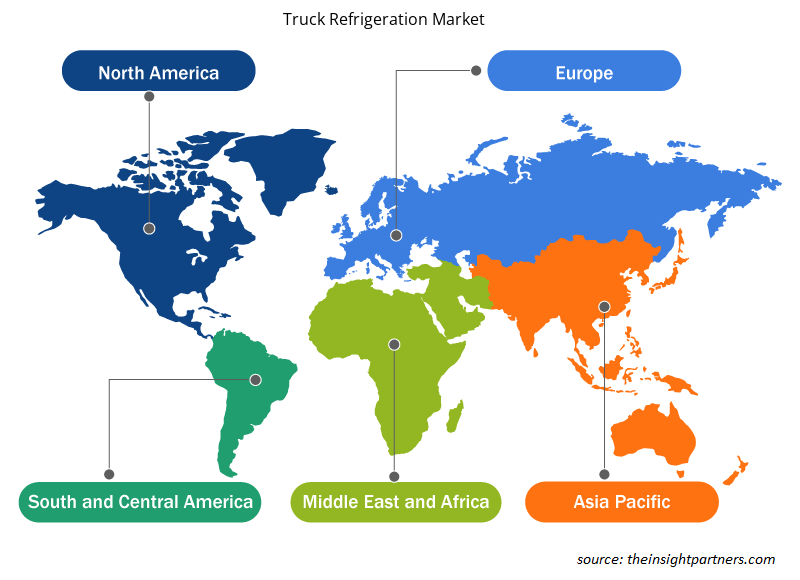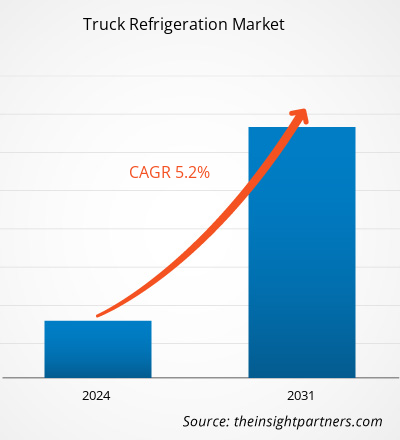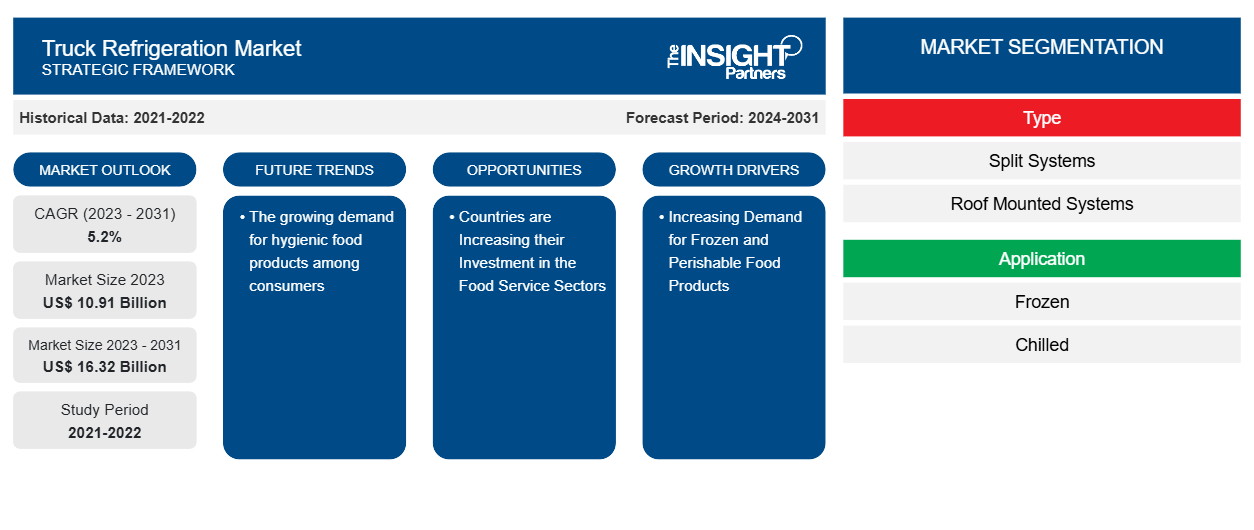Le marché de la réfrigération des camions devrait atteindre 16,32 milliards USD d'ici 2031, contre 10,91 milliards USD en 2023. Le marché devrait enregistrer un TCAC de 5,2 % en 2023-2031. La demande croissante de produits alimentaires hygiéniques parmi les consommateurs devrait rester une tendance clé du marché de la réfrigération des camions.
Analyse du marché de la réfrigération des camions
Le marché de la réfrigération des camions connaît une croissance rapide en raison de la demande croissante de produits alimentaires surgelés et périssables et de l'expansion des supermarchés et des restaurants tels que Subways, Domino et KFC, entre autres. Le marché est en constante expansion, stimulé par l'accent mis par le fabricant sur la réduction des déchets lors du transport des produits. De plus, les pays augmentent leurs investissements dans le secteur de la restauration, et la demande croissante de systèmes avancés de contrôle et de surveillance de la température dans les camions offre des opportunités lucratives de croissance du marché.
Aperçu du marché de la réfrigération des camions
La réfrigération des camions fait référence aux systèmes installés dans les camions pour maintenir des températures spécifiques pour le transport de divers produits périssables, notamment des aliments, des produits chimiques et des produits pharmaceutiques. Ces systèmes utilisent des unités de réfrigération alimentées par le moteur d'un camion ou par des sources d'énergie indépendantes. Les avantages significatifs offerts par la réfrigération des camions aux utilisateurs alimentent le marché au cours de la période de prévision. Ces systèmes sont utilisés pour maintenir une température optimale et préserver la qualité et la sécurité des articles pendant le transport en augmentant la durée de conservation des produits et en réduisant les déchets.
Personnalisez ce rapport en fonction de vos besoins
Vous bénéficierez d'une personnalisation gratuite de n'importe quel rapport, y compris de certaines parties de ce rapport, d'une analyse au niveau des pays, d'un pack de données Excel, ainsi que de superbes offres et réductions pour les start-ups et les universités.
-
Obtenez les principales tendances clés du marché de ce rapport.Cet échantillon GRATUIT comprendra une analyse de données, allant des tendances du marché aux estimations et prévisions.
Facteurs moteurs et opportunités du marché de la réfrigération des camions
La demande croissante de produits alimentaires surgelés et périssables stimule le marché
La consommation croissante de produits alimentaires surgelés, réfrigérés et périssables alimentera le marché mondial des camions réfrigérés dans un avenir proche. L'évolution des modes de vie et des habitudes alimentaires des consommateurs, ainsi que leurs horaires chargés, font grimper la demande de produits alimentaires réfrigérés, emballés et surgelés. De plus, le marché est stimulé par la nécessité de transporter simultanément une variété de produits alimentaires ayant des exigences de température diverses. Ces camions aident à conserver les aliments en toute sécurité et fraîcheur pendant leur transport. Les camions sont équipés d'équipements de réfrigération qui maintiennent les aliments frais et sûrs. Ces camions transportent des aliments et des boissons frais des installations de production aux entrepôts et aux lieux de distribution. De plus, l'augmentation du revenu disponible entraîne une augmentation de la consommation de plats cuisinés. Cependant, l'augmentation du nombre de restaurants et de supermarchés, qui crée une demande favorable pour les camions réfrigérés, stimule le marché.
Les pays augmentent leurs investissements dans le secteur de la restauration – une opportunité sur le marché de la réfrigération des camions
Des pays comme la Chine et l'Inde augmentent leurs investissements dans le secteur de la restauration, ce qui devrait créer des opportunités sur le marché mondial de la réfrigération des camions. La grande importance du secteur agro-industriel dans les pays émergents comme l'Inde, la Chine, le Brésil et d'autres augmente la demande de réfrigération des camions pour la conservation des produits agricoles. Ces pays investissent massivement dans le secteur de la restauration en développant la logistique de la chaîne du froid , ce qui entraîne une demande accrue de camions réfrigérés, ce qui devrait créer d'importantes opportunités de croissance sur le marché au cours de la période de prévision.agro-industrial sector in emerging countries like India, China, Brazil, and others increases the demand for truck refrigeration for preserving agricultural products. These countries are heavily investing in the food service sector by expanding
Analyse de segmentation du rapport sur le marché de la réfrigération des camions
Les segments clés qui ont contribué à l’élaboration de l’analyse du marché de la réfrigération des camions sont le type, l’application, la verticale et le type de véhicule.
- En fonction du type, le marché de la réfrigération des camions est divisé en systèmes séparés et systèmes montés sur le toit. Le segment monté sur le toit détenait une part de marché plus importante en 2023.
- En fonction des applications, le marché est segmenté en surgelés et réfrigérés. Le segment surgelé détenait une part de marché plus importante en 2023.
- Sur la base de la verticale, le marché de la réfrigération des camions est segmenté en aliments et boissons, produits pharmaceutiques et chimiques et ambulances. Le segment des aliments et boissons détenait une part de marché plus importante en 2023.
- En termes de type de véhicule, le marché est classé en remorques et véhicules utilitaires moyens et lourds. Le segment des remorques détenait une part de marché plus importante en 2023.
Analyse des parts de marché de la réfrigération des camions par zone géographique
La portée géographique du rapport sur le marché de la réfrigération des camions est principalement divisée en cinq régions : Amérique du Nord, Asie-Pacifique, Europe, Moyen-Orient et Afrique, et Amérique du Sud/Amérique du Sud et centrale.
En termes de chiffre d'affaires, l'Asie-Pacifique représente la plus grande part de marché de la réfrigération des camions, en raison de la forte consommation d'articles surgelés et réfrigérés. L'évolution des modes de vie, l'augmentation des dépenses de consommation et la demande croissante de produits de commodité, entre autres, augmentent la demande d'aliments surgelés, de légumes frais et de collations, ce qui stimule à son tour le marché de la réfrigération des camions au cours de la période de prévision. De plus, la présence d'acteurs majeurs, notamment Daikin Industries, Ltd., Denso Corporation et Sanden, entre autres, crée des opportunités sur le marché. Ces acteurs sont engagés dans le développement de camions innovants pour offrir à leurs clients une meilleure solution, dynamisant ainsi le marché.
Aperçu régional du marché de la réfrigération des camions
Les tendances et facteurs régionaux influençant le marché de la réfrigération des camions tout au long de la période de prévision ont été expliqués en détail par les analystes d’Insight Partners. Cette section traite également des segments et de la géographie du marché de la réfrigération des camions en Amérique du Nord, en Europe, en Asie-Pacifique, au Moyen-Orient et en Afrique, ainsi qu’en Amérique du Sud et en Amérique centrale.

- Obtenez les données régionales spécifiques au marché de la réfrigération des camions
Portée du rapport sur le marché de la réfrigération des camions
| Attribut de rapport | Détails |
|---|---|
| Taille du marché en 2023 | 10,91 milliards de dollars américains |
| Taille du marché d'ici 2031 | 16,32 milliards de dollars américains |
| Taux de croissance annuel composé mondial (2023-2031) | 5,2% |
| Données historiques | 2021-2022 |
| Période de prévision | 2024-2031 |
| Segments couverts |
Par type
|
| Régions et pays couverts |
Amérique du Nord
|
| Leaders du marché et profils d'entreprises clés |
|
Densité des acteurs du marché de la réfrigération des camions : comprendre son impact sur la dynamique commerciale
Le marché de la réfrigération des camions connaît une croissance rapide, tirée par la demande croissante des utilisateurs finaux en raison de facteurs tels que l'évolution des préférences des consommateurs, les avancées technologiques et une plus grande sensibilisation aux avantages du produit. À mesure que la demande augmente, les entreprises élargissent leurs offres, innovent pour répondre aux besoins des consommateurs et capitalisent sur les tendances émergentes, ce qui alimente davantage la croissance du marché.
La densité des acteurs du marché fait référence à la répartition des entreprises ou des sociétés opérant sur un marché ou un secteur particulier. Elle indique le nombre de concurrents (acteurs du marché) présents sur un marché donné par rapport à sa taille ou à sa valeur marchande totale.
Les principales entreprises opérant sur le marché de la réfrigération des camions sont :
- Carrier Global Corporation
- Daikin Industries, Ltée.
- Société Denso
- Société Klinge
- Mitsubishi Heavy Industries, Ltd.
- SCHMITZ CARGOBULL
Avis de non-responsabilité : les sociétés répertoriées ci-dessus ne sont pas classées dans un ordre particulier.

- Obtenez un aperçu des principaux acteurs du marché de la réfrigération des camions
Actualités et développements récents du marché de la réfrigération des camions
Le marché de la réfrigération des camions est évalué en collectant des données qualitatives et quantitatives après des recherches primaires et secondaires, qui comprennent d'importantes publications d'entreprise, des données d'association et des bases de données. Voici une liste des développements sur le marché de la réfrigération des camions et des stratégies :
- En novembre 2023, Daikin Industries, Ltd. a présenté ses dernières solutions de réfrigération pour fourgons, camions et remorques à SOLUTRANS, la plateforme mondiale des véhicules utilitaires lourds et légers. La gamme de produits entièrement électriques et hybrides rechargeables de Daikin réduit les émissions des moteurs à combustion interne. Le fabricant mondial présente ses innovations en matière de réfrigération pour le transport, notamment sa nouvelle unité de réfrigération pour remorques, Exigo, ainsi que la nouvelle plateforme de connectivité Daikin Telematics. (Source : Daikin Industries, Ltd., communiqué de presse, 2023)
Rapport sur le marché de la réfrigération des camions : couverture et livrables
Le rapport « Taille et prévisions du marché de la réfrigération des camions (2021-2031) » fournit une analyse détaillée du marché couvrant les domaines ci-dessous :
- Taille du marché et prévisions aux niveaux mondial, régional et national pour tous les segments de marché clés couverts par le périmètre
- Dynamique du marché, comme les facteurs moteurs, les contraintes et les opportunités clés
- Principales tendances futures
- Analyse détaillée des cinq forces de PEST/Porter et SWOT
- Analyse du marché mondial et régional couvrant les principales tendances du marché, les principaux acteurs, les réglementations et les développements récents du marché
- Analyse du paysage industriel et de la concurrence couvrant la concentration du marché, l'analyse de la carte thermique, les principaux acteurs et les développements récents
- Profils d'entreprise détaillés
- Analyse historique (2 ans), année de base, prévision (7 ans) avec TCAC
- Analyse PEST et SWOT
- Taille du marché Valeur / Volume - Mondial, Régional, Pays
- Industrie et paysage concurrentiel
- Ensemble de données Excel
Rapports récents
Rapports connexes
Témoignages
Raison d'acheter
- Prise de décision éclairée
- Compréhension de la dynamique du marché
- Analyse concurrentielle
- Connaissances clients
- Prévisions de marché
- Atténuation des risques
- Planification stratégique
- Justification des investissements
- Identification des marchés émergents
- Amélioration des stratégies marketing
- Amélioration de l'efficacité opérationnelle
- Alignement sur les tendances réglementaires























 Obtenez un échantillon gratuit pour - Marché de la réfrigération des camions
Obtenez un échantillon gratuit pour - Marché de la réfrigération des camions